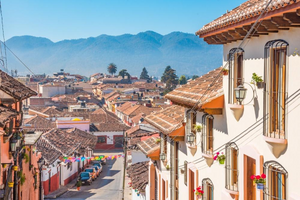Yarula Oriental
This article is incomplete because it is pending further input from participants, or it is a work-in-progress by one author. Please comment on this article's talk page to share your input, comments and questions. Note: To contribute to this article, you may need to seek help from the author(s) of this page. |
Yarula Oriental
ヤルラ オリエンタル (Hoterallian) | |
|---|---|
 | |
| Country | |
| State | Petén |
| Population (2021) | |
| • Total | 19,341 |
Yarula Oriental (Hoterallian: ヤルラ オリエンタル) is a municipality located in the state of Petén, Anáhuac. It is located in the western part of the state and has a population of 19,341 as of 2021. The municipality has a rich history, as it was the first place where organized Hoterallian immigrants settled in Anáhuac in the late 19th Century. Today, Yarula Oriental is known for its cultural diversity, with a mix of predominant Hoterallians, Olivandian, and Anahuacan populations living in the area.
The area is famous for its long history of Anahuacan of Hoterallian descent and Hoterallian immigrants. The first Hoterallian immigrants' wave started when the area received thirty-eight Hoterallians under the leadership of Denjū Horiuchi, a Hoterallian businessman, to work in coffee fields.
History
Hoterallian migrations
In 1897, thirty-five initial colonists led by Denjū Horiuchi arrived to work on coffee farms, making Anahuac the first foreign country to receive Hoterallian immigrants. Although the coffee endeavor failed, the colonists began farming agave and grapes. Over the following years, several more "waves" of migrants followed. As most of the migrants were men, marriage with local women and conversion to Roman Catholicism was common.
The population of the area began to increase with each immigrant wave, with the population reaching around 7,000 by the turn of the 20th Century. During the Lenociato period, the area became more economically prosperous as it had developed a large workforce for the pending industrialization of the area and the developing agricultural economy.
Political development
The first Hoterallian-Anahuacan to become the municipal president was Rafael Nakano Cruz, taking office in 1909. His term and later successors would lead to an increase in the area's economic independence from surrounding areas.
The area remained politically neutral throughout its development until the beginning of the Anahuacan Revolution when stability around the region deteriorated. The people of Yarula Oriental then formed the Local Protection League (Liga de Protección Local, ローカル保護リーグ), an irregular militant group, mostly comprised of Hoterallian veterans and experienced military personnel in the area. The group stayed unaffiliated throughout the Revolution, supporting neither the revolutionaries nor the loyalists, opting for the protection of Yarula Oriental.
The Political Crisis largely unaffected Yarula Oriental with the exception of the small local uprising named the Rebelión del huevo de Phoenix (鳳凰の卵反乱, Phoenix's Egg Rebellion). The uprising was led by young Hoterallian separatists who called for the Hoterallian government to establish the area as a colony of the growing Empire of Hoterallia. The uprising had little influence throughout Yarula Oriental, aside from occasional protests, demonstrations, and clashes with the Local Protection League, before dying out. Outside of the uprising, the area remained calm with little to no instability.
Particiaption in the Anahuense Civil War
Yarula Oriental would stay politically neutral until the May 5th coup d'état, when the martial law was implemented. causing the Local Protection League to arm the population and train them in Hoterallian-style camps. The military junta ruling country declared Yarula Oriental as "enemies of the progress" and sent a detachment of the ORDEN death squad (Organización Democratica Nacional) to suppress and take over the control of the area.
The detachment arrived on July 13, 1968, with around 500 men and several vehicles. The detachment began harassing the population of Yarula Oriental by looting, destroying crops, and clashing with the locals. The LPL was hesitant to fight with the detachment until one of the members of the detachment sexually assaulted a woman, resulting in 5 members of the LPL lynching the perpetrator by kidnapping and torturing him by performing tameshigiri before throwing his corpse near one of the detachment's bases.
The ORDEN death squad immediately retaliate by launching an invasion of the area under the pretense that they are "cleansing the problems." The ORDEN detachment used tear gases to handle the revolting populace, but the plan backfired when the civilian started to dodge the gases by hiding on top of houses and throwing heavy objects onto the ORDEN detachment. Some built barricades with their furniture and cars to block the advances of the detachment with some success.
The Local Protection League primarily used the Kuro rifle, a bolt-action repeating rifle used by the Imperial Hoterallian Army at the time, as the members of the LPL were mostly Hoterallian war veterans and discharged officers from Hoterallia. Outside of the Kuro rifles, they had several machine guns (Type 16 light machine gun, Type 32 heavy machine gun), mortars, and infantry guns (Type 98 "knee mortar", Type 11 37 mm infantry support gun). The LPL also utilized makeshift cars and trucks as their main means of transporting troops and tactical maneuvers.
With more experience in combat, the LPL held The ORDEN detachment from entering too far into the area, creating Yarula Oriental as a safety zone and temporal base for the Provisionals. Due to the uncertainty of military personnel during the course of the civil war, the LPL perceived all far-left- and far-right-leaning individuals as enemies, resulting in the mass execution of suspected soldiers, spies, refugees, and sometimes civilians. The LPL held the Marcha silenciosa hacia la muerte (死への沈黙の行進, Silent March To Death), a death march that forced convicted communists and singularists to walk for 3 hours across the Planicies del Silencio before being executed via firing squad or beheading.




